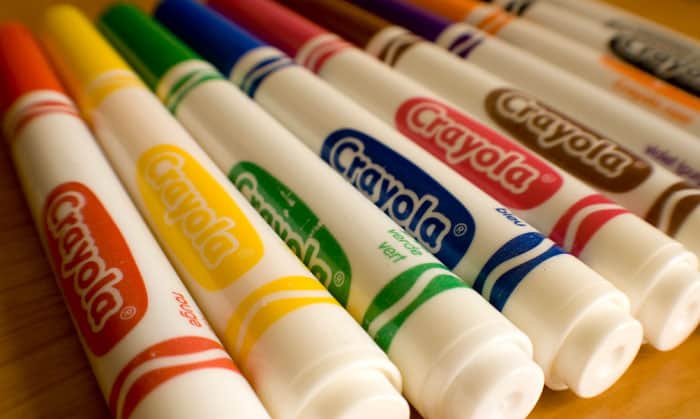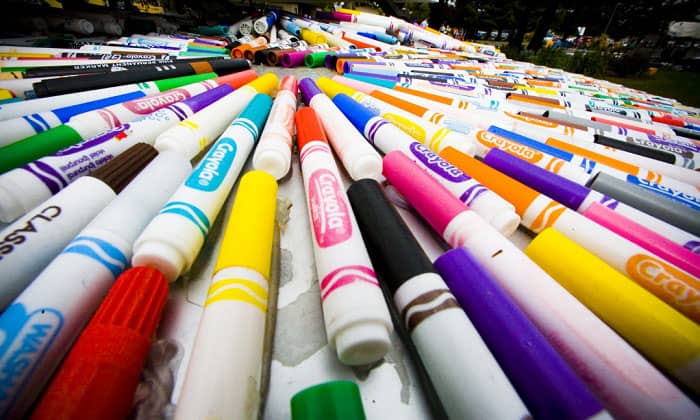Many parents and educators are worried about what children use in art activities. If you’re one of them, you must be eager to learn the answers for ‘What are Crayola markers made of?’ By being particular with its components, you would know if the object is toxic to human skin.
Crayola markers have five components: the porous plastic nib, water-based color solution, cotton filament, cap, and plastic barrel. The color solution in every marker is made of water and dye.
Apart from its effectiveness as a marker, you may want to dig deeper and learn about these components. So, read on!.
Table of Contents
Quick History of Crayola Marker
Harold Smith and Edwin Binney invented Crayola markers in 1978. In 1987, washable Crayola markers were released. This particular type of marker is a success as 465 million pieces are produced every year.
The ink solution of Crayola markers is made of water, dye, and some proprietary ingredients. With the resin and injection molding process, the cap, plastic barrel, and cylinder are made.
Ingredients Used in Making Crayola Markers
Paraffin is the main ingredient in the production of markers and crayons. According to Crayola, another primary ingredient is color pigment. But I must say that the company didn’t reveal its secret ingredients.
Almonds, legumes, latex, milk casein, peanuts, red coloring, and tree nuts are some of the Crayola marker ingredients that are disclosed. As mentioned earlier, these markers contain paraffin wax.
Paraffin is made from coal, petroleum, or oil shale. The process of making this wax doesn’t guarantee the absence of harmful substances. Hence, you can’t conclude that these markers are completely non-toxic despite the marks of Crayola on their products.
The paraffin wax, in melted form, is combined with color pigments. It takes four to seven minutes to cool and solidify the markers, then they proceed to mold machines.
Although the company has hidden some ingredients in Crayola markers, I can name two of them. They’re beef tallow and filler like kaolin or talc based on what my senses can detect.
Looking Deeper on the Ingredients and the Effects on Humans
1. Safety concern
Crayola markers and Silly Putty are non-toxic. This is not only stated by the company but it’s also supported by the findings of an independent toxicologist. Therefore, it’s no wonder that Crayola products have been used by toddlers and children through generations.
Although it doesn’t raise a red flag, these products can cause stomach ache when consumed since they’re not categorized as edibles.
2. Being vegan
Due to nearly a century of Crayola operation, it’s no wonder that it’s a part of popular culture. Based on research, 99% percent of households can immediately recognize this brand. Many children all over the world spent time with Crayola products to relax and be creative.
However, are Crayola markers vegan? Some are dying to know the answer to this question. Sadly, they’re not vegan-friendly. Glue, tempera paint, and watercolor are added since the pigments and paint need some things for better flow, binding, adherence, and color. Other ingredients are beeswax, bone char, bug shells, cow’s milk, eggs, gelatin, and honey.
If you follow Crayola on Twitter, they said once that they don’t test their products on animals. Nonetheless, the company didn’t deny that they use some animal by-products. Are Crayola markers made from animals? The answer is partly ‘yes’ because of the wax, milk, and other related components.
There was a study conducted in 1982 about the content of the Crayola markers. If you’re used to these things, you can recognize them even with your eyes closed due to their smell. The researchers found out that its smell is one among the 20 odors that participants can easily determine.
These markers have a waxy texture because of beef fat that’s considered the source of stearic acid. This is also the cause of their strong smell. Therefore, they’re non-vegan. Nevertheless, there are vegan markers like Faber Castell Pitt Artist Marker, Chartpak Spectra AD Marker, and Copic Marker Classic Markers.
3. About the inclusion of beef fat or stearic acid
You may be curious why Crayola has chosen beef fat. The main reason is that it’s a source of stearic acid which can strengthen the markers. Let’s look at the scientific basis for further explanation.
Stearic acid is a type of long saturated fatty acid from cow’s fat. It becomes waxy solid when placed under room temperature. Furthermore, it contains a carboxyl group that can develop esters with glycerol. This process allows the members of the group to stack on top of each other. Therefore, stearic acid is an excellent hardening agent for organic molecules.
Crayola has already admitted to using animal by-products so you can eliminate vegetable products on the list. It’s just a reasonable hunch even though Crayola isn’t willing to disclose all its ingredients.
Apart from naming the ingredients, it’s great to look at the quantity percentage. Paraffin wax and color pigment take up at least 80% of the Crayola marker. Only 20% is left for the rest of the ingredients, such as stearic acid or tallow.
4. Effects on skin
A toxicologist has already assured the non-toxicity of Crayola markers so whether you inhale or ingest it, you don’t need to be in a qualm. This implies that they’re safe for the skin as well. Children can use them but don’t allow them to play body art with these markers.
Regarding this matter, only use items that are designated for face and skin use. Unlike Crayola products that are not skin application, certain products have been through tests and approvals to be recommended for skin use.
Summing Things Up
This article has addressed your curiosity on ‘What are Crayola markers made of?’ Although the company didn’t unveil all the ingredients, the information and study by experts are enough to prove that it’s non-toxic. It’s also crystal clear that it’s not vegan-friendly but safe for the skin.

Art has always been a part of my life; it influences my upbringing and later my career choice. For me, it is always a part of my parenting technique. So for whichever purpose that you come to art, you can start here with us.


